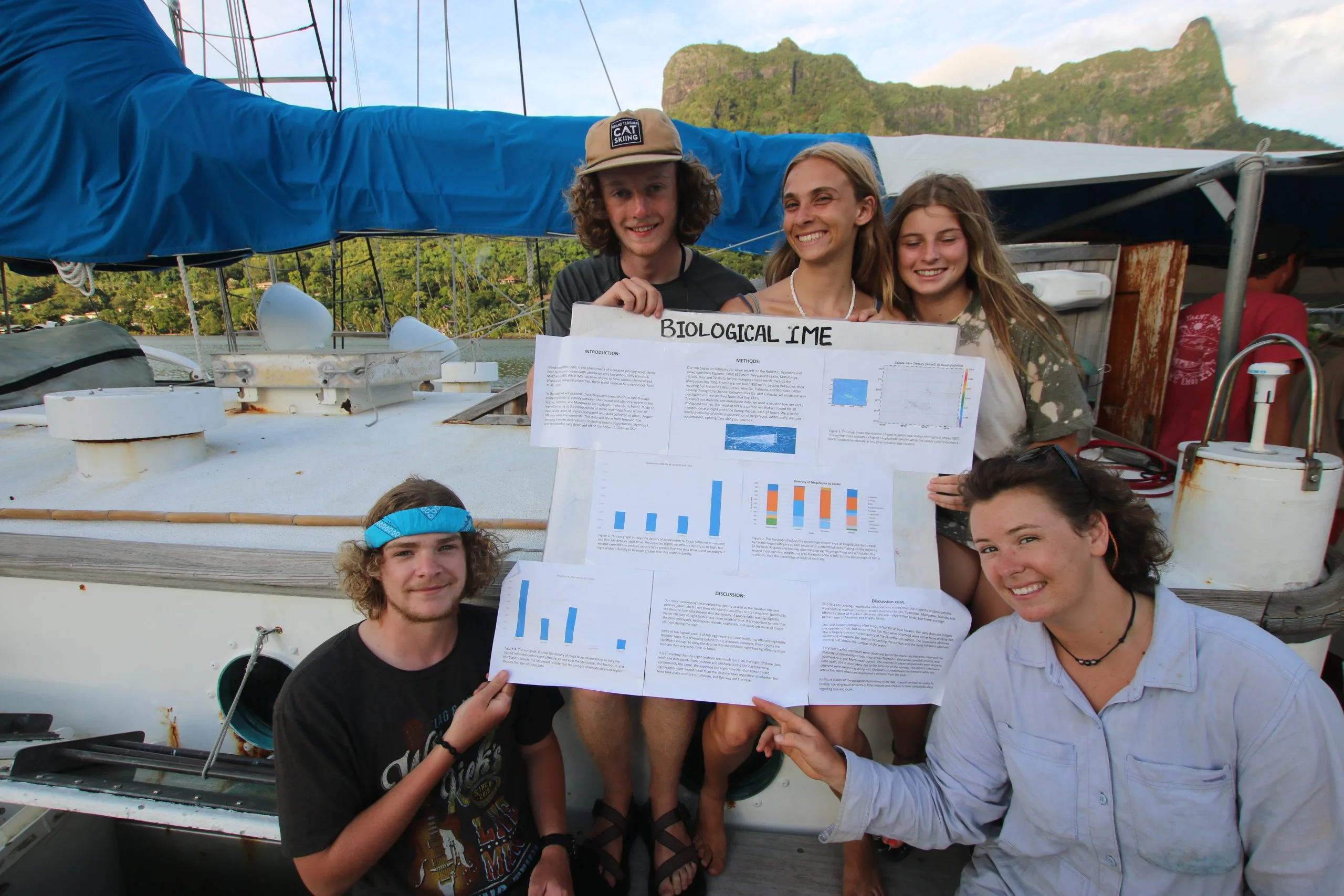Programs Blog
Oceanography Presentations!

Jeff Schell, Chief Scientist
Ship’s Log
Log
2172 Nautical miles
Ship Speed and Location
Anchored in Cook’s Bay, Mo’orea, French Polynesia
Winds and Weather
NNW Beaufort Force 3
Seas NW ~ 1 ft. (nice and protected here)
Skies, ¾ cumulous clouds.
Today we celebrated several accomplishments. First, our successful return to Mo’orea after nearly a month-long voyage at sea. We shared 2172 nautical miles together as we sailed to the Tuamotus and Marquesan Islands and back again. We have a few more miles to go until our final stop in Tahiti, but for now we are comfortably anchored in Cook’s Bay, just a short distance away from Gump Marine Science Station where our adventures in French Polynesia began. It was nice to go ashore briefly and say hello to friends and invite them to come aboard for a visit. However, the main event for today were final oceanography presentations!
 Shay, Lila, Sofie (top row), Rosie and Nils describe the physical mechanisms of IME.
Shay, Lila, Sofie (top row), Rosie and Nils describe the physical mechanisms of IME.
The students were asked to determine if there was evidence of the Island Mass Effect occurring at any point along our cruise track and to describe it’s characteristics. Mass in this case refers to biomass- the abundance of marine life found around these tropical Pacific Islands. The Mass Effect is an ocean phenomenon that sometimes occurs around islands that helps explain Charles Darwin’s age-old question – How is it possible for tropical islands to support the abundance and diversity of corals, fishes, and invertebrates when they are surrounded by an ocean that is otherwise quite low in marine life? How is this oasis of biodiversity supported? Where do all the nutrients come from to supply such a diverse and abundant food web? These questions represent the basis of what scientists have termed, Darwin’s Paradox. The hypothetical resolution to Darwin’s Paradox being the complex physical, chemical, and biological mechanisms that make up the Island Mass Effect (IME).
In their Watch groups, students explored these questions. During our 2172 nautical miles of sailing, we also did a ton of science. Every day and every night – science doesn’t sleep! The students deployed all manner of scientific equipment, processed samples in the lab, and worked with various instruments such as the spectrophotometer and fluorometer. Under the microscope they tirelessly identified alien-like plankton such as copepods, chaetognaths, and pteropods; not to mention diatoms and dinoflagellates.
 Sophie, Flora, Ben, Una, Massi and Eden describe the chemical effects of IME
Sophie, Flora, Ben, Una, Massi and Eden describe the chemical effects of IME
They measured pH, chlorophyll-a and nutrient concentrations. They bio-volumed plankton, recorded secchi disc depths and interpreted vertical profiles of temperature. They tracked patterns of seabirds and characterized the currents every hour of our voyage. They looked for, and found, the mythical PhytoPlankton City! After all these labors followed days of discussion, data analysis, and crafting of posters. In the end, not only did the students find evidence of the Island Mass Effect; they also discovered the IME occurred multiple times, was expressed in unique ways, and was driven by different mechanisms around each island!
Therefore, congratulations are in order, for a job well done. Thanks to the captain and crew for guiding us safely to so many different islands. And thanks to all the students for their hard work and diligent efforts making sense of all the oceanographic data!
I could not be more pleased!
Cheers,
Schelly, Chief Scientist
Recent Posts from the Ships
- SEA Writer 2022, Magazines From the Summer SEA Quest Students
- PIPA Alumni Reconnect with Children of Kanton
- Woods Hole Welcomes Incoming Class of PEP Students
- Muhlenberg Student Finds Perfect Study Abroad Experience with SEA Semester
- SEA Student Describes Pacific Exploration for University of Denver News
Programs
- Gap Year
- Ocean Exploration
- High School
- Science at SEA
- SEA Expedition
- SEAScape
- Pre-College
- Proctor Ocean Classroom
- Protecting the Phoenix Islands
- Sargassum Ecosystem
- SPICE
- Stanford@SEA
- Undergraduate
- Climate and Society
- Climate Change and Coastal Resilience
- Coral Reef Conservation
- Marine Biodiversity and Conservation
- MBL
- Ocean Exploration: Plastics
- Ocean Policy: Marine Protected Areas
- Oceans and Climate
- Pacific Reef Expedition
- S-299 Summer Session
- The Global Ocean: Hawai'i
- The Global Ocean: New Zealand